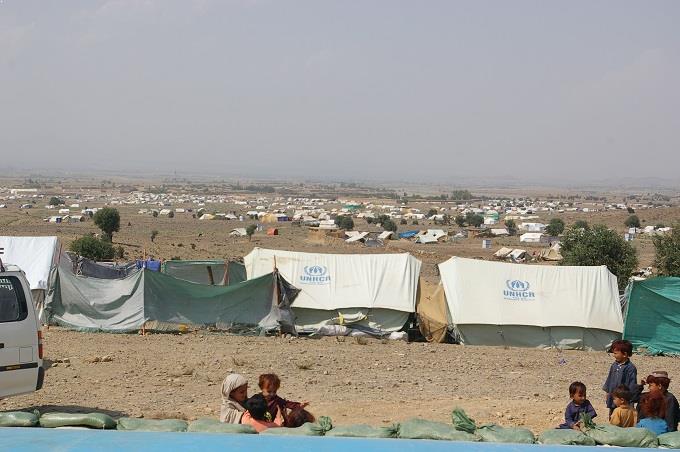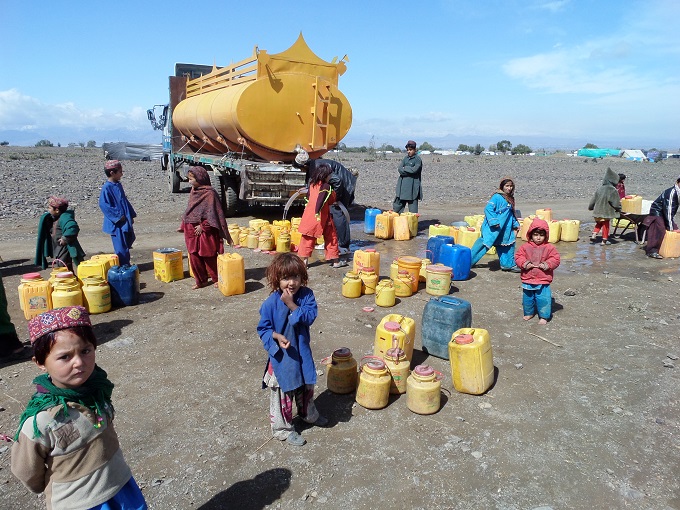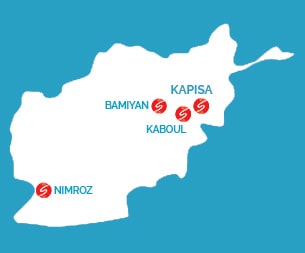For a year now, thousands of refugees have been crossing the Afghan border, fleeing the fighting between the Pakistani army and the Taliban in the province of Waziristan. Our head of mission, Philippe Bonnet, sheds light on the situation.
They began arriving in Afghanistan from mid-June 2014 on, in the days following the start of the Pakistani army offensive in North Waziristan. While hundreds of thousands of people moved away from the combat zones to calmer regions in Pakistan, ten thousand families chose to cross the Afghan border, the famous “Durand Line” that artificially separates the Pashtun tribes between Afghanistan and Pakistan since 1893. Needless to say that in the eyes of these families settling in the Afghan provinces of Paktika and Khost a “border” is of little value. Moreover, in the first weeks of the crisis, Afghan authorities are reluctant to talk about refugees, preferring the interesting term “displaced persons having crossed a border” and delegating the crisis management to the authority of the Ministry of Tribal Affairs and Borders. The refugees meanwhile do not care about distinctions and begin to settle with relatives or with foster families. Others, who do not have this opportunity, settle in the Gurbuz district on arid and stony ground where nothing grows, deprived of water and shade and bordered by hills, ten kilometers south of the border with Pakistan. This means the spontaneous origins of the Gulan refugee camp.

“ We were refugees in Pakistan and the Pakistani helped us. It is our turn now to help them.”
Some arrive by car, others on foot carrying some belongings, their most valuable assets, small stocks of food, whatever they had the time and opportunity to seize. Quickly, makeshift camps arise where households gather by family and begin to settle. It is the period of Ramadan, the weather is warm and the surrounding communities host these refugees willingly: “We were refugees in Pakistan, the Pakistani helped us, now it is our turn to help them”. Ramadan stands for sharing and the surrounding communities give food to the poorest. The merchants of the city of Khost, a few tens of kilometers away, contribute to send water trucks to those few thousand people, a company even installs a drill on this land previously disputed by surrounding tribes. Soon, assistance is organized, NGOs begin distributing essential items and Doctors Without Borders (MSF) installs a health center in a school serving the surrounding villages and located at the edge of the camp, with bladders to improve access to water and several communal latrines dug with the help of camp residents. By the end of September 2014, SOLIDARITÉS INTERNATIONAL takes over the water, hygiene and sanitation component with funding from the European Commission, when the camp is housing fifteen thousand people who intend to return home by spring.
Return to Pakistan? Today, this seems unlikely
is very different, counting over 65,000 inhabitants. A market has developed, around ten schools provide primary education to children, a health center was built, and about forty mosques gather the faithful for prayer. Gradually, camp canvas has been replaced by houses of mud brick, certainly very similar to the design of the houses the refugees left in North Waziristan. Social structures have developed and an assembly of elders (Shura) resolves conflicts between refugees and between the different tribes that make up the camp population. These elders are the natural relay between the community and the organizations that support it.
Return to Pakistan? Today, this seems unlikely as on May 15, a new offensive triggered by the Pakistani army, with drones circling the sky searching for targets and with Taliban fighters remaining elusive.

Blocks of family latrines to ensure the women’s access to sanitation
The teams of SOLIDARITÉS INTERNATIONAL have had to adapt to this changing situation. The infrastructure ensuring access to water has continued to grow. Eventually, ten wells will produce more than one million liters of drinking water daily allowing each refugee to have a minimum of fifteen liters of water per day and ensuring the water supply of community structures (health center, schools, etc.).
Blocks of family latrines and emergency showers are gradually being installed in each camp. Five thousand will be required to enable each family to have access to sanitation infrastructures adapted to their cultural environment. The installation of public latrines could not ensure the women’s access to these essential infrastructures. Ultimately, taking into account the evolution of the habitat in the camp, more sustainable latrines should be provided for. Waste management is also managed at camp level by SOLIDARITÉS INTERNATIONAL through garbage bins distributed throughout the camp and emptied daily by refugees in pits arranged for that purpose.
SOLIDARITÉS INTERNATIONAL teams also promote good hygiene practices in the camp, ensuring the adaptation of these populations, often from rural areas, to life in a refugee camp where the population is denser with consecutive higher health risks. Hygiene promotion sessions are organized in schools and mosques but also at household level. To facilitate these sessions, the social codes of these traditionalist populations had to be taken into account. Only a woman can enter the camps and have access to families, women and children refugees. Today, a team of six female hygiene promoters has daily contact with the camp’s women to spread good hygiene practices in the community. In order to support the dissemination of these practices, essential items such as soap, detergent or water tanks are distributed.
All activities are discussed ahead with the Shura in order to ensure the feasibility, acceptance and ownership of the project by its beneficiaries.
The future is uncertain. The refugees themselves do not forecast any return in the near future. Some even plan to stay several years, which in fact seems to be confirmed with the construction of more sustainable shelters by the refugees themselves. Obviously, their fate is linked to the evolution of the military and political situation in Pakistan, to the relation between Afghanistan and Pakistan and it would be risky, to date, to make predictions about a possible resolution of this crisis.
Support our action
Afghanistan
Context and action- 43 inhabitants
- 180th out of 191 countries on the Human Development Index
- 146.500 people helped

